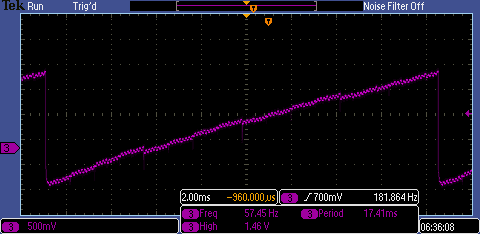|
Way Past Spec

|
|
As the price of 3.3v SPI Flash memories was next to nothing, Sylvie was
made to run completely off 3.3V power aside from the battery charging circuit.
This caused problems for two components, in particular the PIC16C73 microcontroller
used for her brain and the DAC-08 for her voicebox. The PIC16C73s I found in
the bin were spec'd to operate with a minimum VDD of 4V, but about 60% of them
could tolerate 3.3V.
The real challenge was the DAC-08. For those not familiar with the component, this
is an older parallel DAC which requires a bipolar supply of +/-10V or more to operate
comfortably. Using a unipolar 3.3v supply results in heavily clamped output with the
transition area far too distored to be useful. However, I found that by reversing the
Vref pins (pulling Vref- to +3.3v and Vref+ to GND) a sweep from $00 - $FF on the DAC
would result in the waveform shown to the left.
|
|



